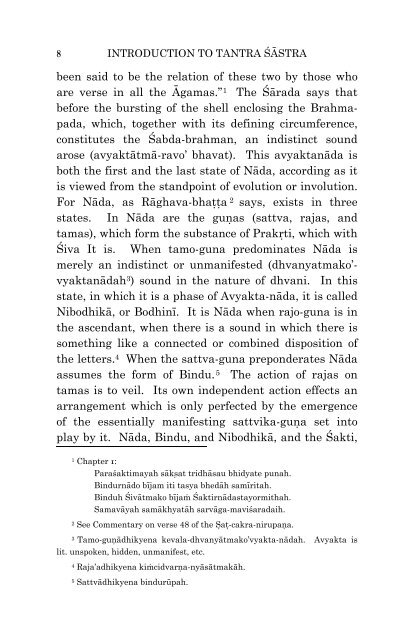Introduction to Tantra Sastra - Aghori
Introduction to Tantra Sastra - Aghori
Introduction to Tantra Sastra - Aghori
Create successful ePaper yourself
Turn your PDF publications into a flip-book with our unique Google optimized e-Paper software.
8<br />
INTRODUCTION TO TANTRA ŚĀSTRA<br />
been said <strong>to</strong> be the relation of these two by those who<br />
are verse in all the Āgamas.” 1 The Śārada says that<br />
before the bursting of the shell enclosing the Brahmapada,<br />
which, <strong>to</strong>gether with its defining circumference,<br />
constitutes the Śabda-brahman, an indistinct sound<br />
arose (avyaktātmā-ravo’ bhavat). This avyaktanāda is<br />
both the first and the last state of Nāda, according as it<br />
is viewed from the standpoint of evolution or involution.<br />
For Nāda, as Rāghava-bhaṭ ṭ a 2 says, exists in three<br />
states. In Nāda are the guṇ as (sattva, rajas, and<br />
tamas), which form the substance of Prakṛ ti, which with<br />
Śiva It is. When tamo-guna predominates Nāda is<br />
merely an indistinct or unmanifested (dhvanyatmako’-<br />
vyaktanādah 3 ) sound in the nature of dhvani. In this<br />
state, in which it is a phase of Avyakta-nāda, it is called<br />
Nibodhikā, or Bodhinī. It is Nāda when rajo-guna is in<br />
the ascendant, when there is a sound in which there is<br />
something like a connected or combined disposition of<br />
the letters. 4 When the sattva-guna preponderates Nāda<br />
assumes the form of Bindu. 5 The action of rajas on<br />
tamas is <strong>to</strong> veil. Its own independent action effects an<br />
arrangement which is only perfected by the emergence<br />
of the essentially manifesting sattvika-guṇ a set in<strong>to</strong><br />
play by it. Nāda, Bindu, and Nibodhikā, and the Śakti,<br />
1 Chapter 1:<br />
Paraśaktimayah sākṣat tridhāsau bhidyate punah.<br />
Bindurnādo bījam iti tasya bhedāh samīritah.<br />
Binduh Śivātmako bījaṃ<br />
Śaktirnādastayormithah.<br />
Samavāyah samākhyatāh sarvāga-maviśaradaih.<br />
2 See Commentary on verse 48 of the Ṣ aṭ -cakra-nirupaṇa.<br />
3 Tamo-guṇādhikyena kevala-dhvanyātmako’vyakta-nādah. Avyakta is<br />
lit. unspoken, hidden, unmanifest, etc.<br />
4 Raja’adhikyena kiṃ<br />
cidvarṇa-nyāsātmakāh.<br />
5 Sattvādhikyena bindurūpah.

















